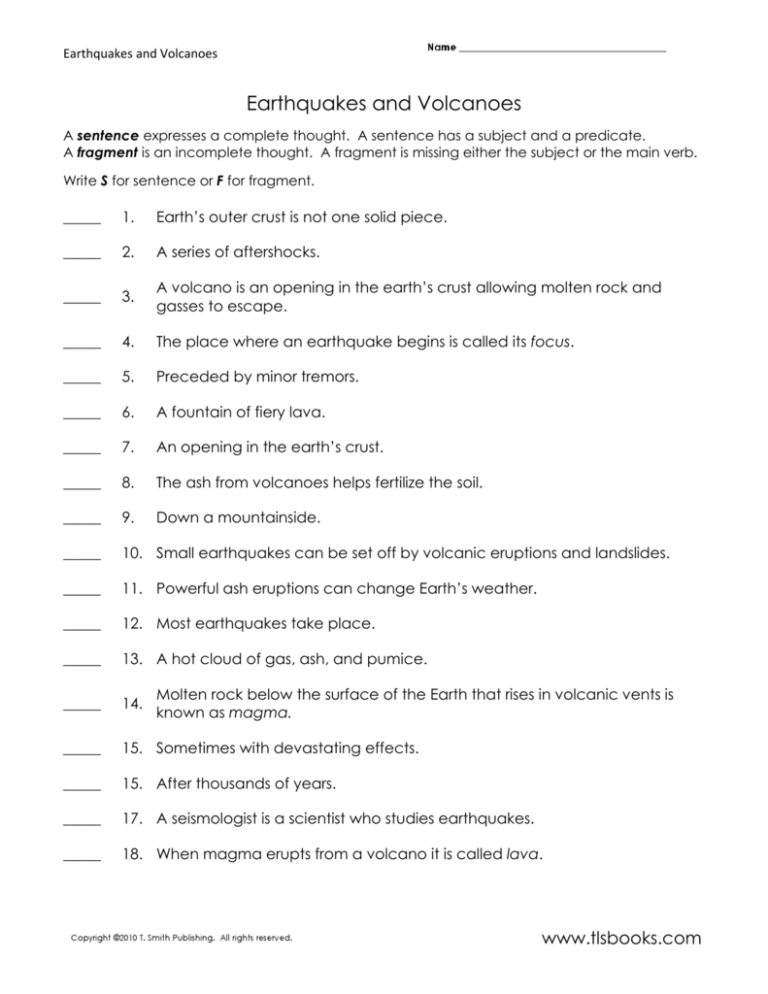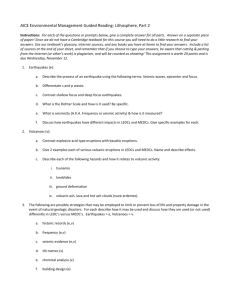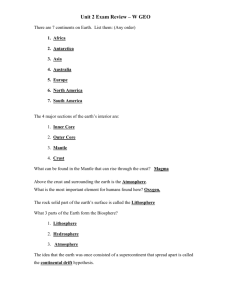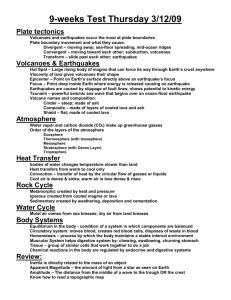Earthquakes and Volcanoes
advertisement

Earthquakes and Volcanoes Earthquakes and Volcanoes A sentence expresses a complete thought. A sentence has a subject and a predicate. A fragment is an incomplete thought. A fragment is missing either the subject or the main verb. Write S for sentence or F for fragment. _____ 1. Earth’s outer crust is not one solid piece. _____ 2. A series of aftershocks. _____ 3. A volcano is an opening in the earth’s crust allowing molten rock and gasses to escape. _____ 4. The place where an earthquake begins is called its focus. _____ 5. Preceded by minor tremors. _____ 6. A fountain of fiery lava. _____ 7. An opening in the earth’s crust. _____ 8. The ash from volcanoes helps fertilize the soil. _____ 9. Down a mountainside. _____ 10. Small earthquakes can be set off by volcanic eruptions and landslides. _____ 11. Powerful ash eruptions can change Earth’s weather. _____ 12. Most earthquakes take place. _____ 13. A hot cloud of gas, ash, and pumice. _____ 14. _____ 15. Sometimes with devastating effects. _____ 15. After thousands of years. _____ 17. A seismologist is a scientist who studies earthquakes. _____ 18. When magma erupts from a volcano it is called lava. Molten rock below the surface of the Earth that rises in volcanic vents is known as magma. www.tlsbooks.com Earthquakes and Volcanoes Earthquakes and Volcanoes A sentence expresses a complete thought. A sentence has a subject and a predicate. A fragment is an incomplete thought. A fragment is missing either the subject or the main verb. Write S for sentence or F for fragment. S 1. Earth’s outer crust is not one solid piece. F 2. A series of aftershocks. S 3. A volcano is an opening in the earth’s crust allowing molten rock and gasses to escape. S 4. The place where an earthquake begins is called its focus. F 5. Preceded by minor tremors. F 6. A fountain of fiery lava. F 7. An opening in the earth’s crust. S 8. The ash from volcanoes helps fertilize the soil. F 9. Down a mountainside. S 10. Small earthquakes can be set off by volcanic eruptions and landslides. S 11. Powerful ash eruptions can change Earth’s weather. F 12. Most earthquakes take place. F 13. A hot cloud of gas, ash, and pumice. S 14. F 15. Sometimes with devastating effects. F 15. After thousands of years. S 17. A seismologist is a scientist who studies earthquakes. S 18. When magma erupts from a volcano it is called lava. Molten rock below the surface of the Earth that rises in volcanic vents is known as magma. www.tlsbooks.com







